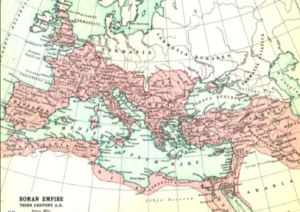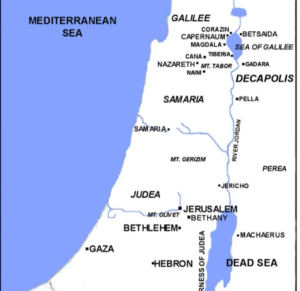Luke’s Gospel shares the most information about Jesus’ journey here on earth while proclaiming the Kingdom of God. With that in mind, it’s helpful to have the historical framework and see the geography of the time. Here is a picture of the Roman Empire in the first century AD.
The Roman Empire
 The Romans conquered most of the known world in the first and second Century BC. Most of us recall Julius Caesar, Mark Anthony, Pompei and all those conquerors who led great campaigns of expansion even, for example, in Paul’s homeland in Turkey. They’d only been under Roman domination for about 80 or 100 years by the time Paul was born. The same thing is true for Palestine. The Roman Empire is the successor to the Hellenistic Empire of Alexander the Great who also expanded his empire beyond known borders. Those who inherited his empire did not rule effectively, allowing the Roman Empire to eventually overcome.
The Romans conquered most of the known world in the first and second Century BC. Most of us recall Julius Caesar, Mark Anthony, Pompei and all those conquerors who led great campaigns of expansion even, for example, in Paul’s homeland in Turkey. They’d only been under Roman domination for about 80 or 100 years by the time Paul was born. The same thing is true for Palestine. The Roman Empire is the successor to the Hellenistic Empire of Alexander the Great who also expanded his empire beyond known borders. Those who inherited his empire did not rule effectively, allowing the Roman Empire to eventually overcome.
By the time Jesus is born in Palestine, between either 4 or 6 AD, Palestine is firmly under the Roman boot. This is an important framework because throughout the Gospel of Luke, you see oppressed and resentful people. In spite of this clear oppression Jesus calls them to love their enemies. The “enemies” Jesus speaks of were immediately known by the common folk as the Roman invaders: Roman soldiers, the Roman governor in Caesarea, Roman oppression, King Herod and his court, and the tax collectors who work for the Romans.
 Israel
Israel
This map of Israel is a contemporary one, so it’s a little different than the time of Jesus. But mostly I want you to see that the backdrop of Israel is going to be the backdrop of the Gospel of Luke. When Luke describes Jesus’ travels from Capernaum and Jerusalem, we see exactly where these places are. When Jesus goes to Magdala or to Naim to raise the son of the widow of Naim, the little Palestinian village is still there.
When we talk about Bethsaida and the towns around the Lake of Galilee, where are they? Well, here they are. The map doesn’t show it here, but above is Syria, Jordan is to the side, and Egypt is to the bottom.
Jesus is born down in Bethlehem of Judea. These are all regions that Luke talks about and the life and travels of Jesus come to life within these context. The region north of Galilee is under Roman domination. Luke speaks about the Phoenician cities of Tyre and Sidon in modern day Lebanon. They were only 12 miles north of the Israel/Lebanon border. The Phoenician/Canaanite religions promoted gruesome and bloody rituals like human and child sacrifice.
The northernmost territory is Galilee. Galilee was Jesus’s home turf. The Sea of Galilee, also known as the Lake of Tiberias, was surrounded by the towns that we’re going to come to know very well when we study Luke, because we’re going to be talking about Capharnaum, also known as Capernaum, Bethsaida, and Corazim. None survive to this day. And we’ll find out why. In the Gospel of Luke, Jesus prophesies the destruction of these towns because they did not accept the Messiah, as well as their eventual annihilation. And then, of course, we have Nazareth.
Mount Tabor, where the Transfiguration occurs, is a large landmark. We have the little town of Naim, and we have Mount Carmel. Mount Carmel is where Elijah called fire down upon the sacrifices offered by the prophets of Baal in the pay of the Phoenician wife of the King of Israel, Jezebel.
A Journey Narrative
So, you see where everything is related geographically. The whole story of Luke is a journey narrative. It starts in Bethlehem with Christ’s birth, and then it picks back up in Nazareth, and then in all the regions around Galilee, and he preaches around the Sea of Galilee. And then he goes south, because he’s on his way to Jerusalem.
Why is he going to Jerusalem? He’s going to Jerusalem to die.
With the understanding of the region comes a deeper connection to Jesus’ journey as told by Luke and his mission here on earth to proclaim the Kingdom of God.
